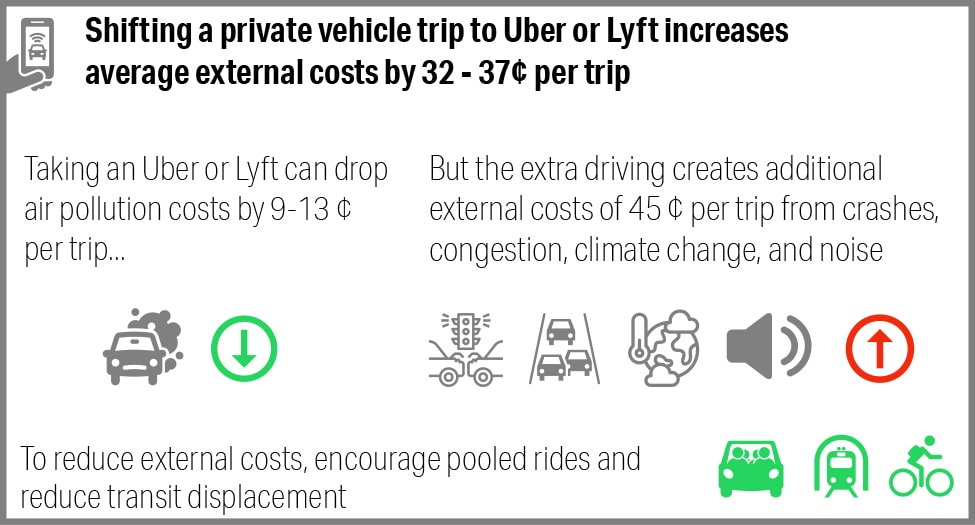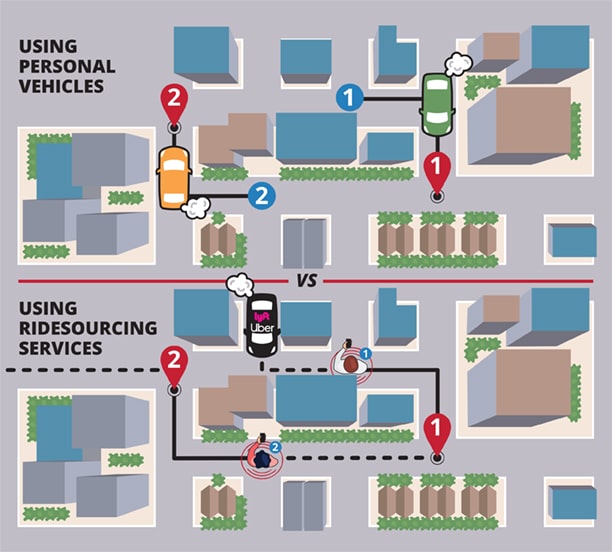Who's Paying For Your Uber?
By Dan Carroll
Media Inquiries- College of Engineering
A new study from Carnegie Mellon University Ph.D. alumnus Jacob Ward, Jeremy Michalek, professor of engineering and public policy, mechanical engineering and director of the Carnegie Mellon Vehicle Electrification Group, and Costa Samaras, associate professor of civil and environmental engineering, quantifies the costs and benefits of taking a trip with a transportation network company (TNC), like Uber or Lyft. They found that a TNC trip actually decreases local air pollution, on average, compared to driving a personal vehicle.
"When a vehicle first starts up, it produces a high level of noxious air pollution until its pollution control system heats up enough to be effective," explained Michalek.
A prior study by Allen Robinson, head of the department of mechanical engineering, and others found that for some pollutants the emissions from a single vehicle start were equivalent to those from hundreds of miles of hot travel. "Since an Uber usually arrives hot when it picks you up, we wondered if it might offer net air quality benefits relative to starting up a personal vehicle for the same trip," said Michalek.
To answer this question, the team collected data on TNC vehicles and personal vehicles and modeled the air pollution consequences of vehicle starts and hot vehicle travel, as well as the extra travel of TNCs between ride requests. "TNC vehicles tend to be newer," explained Samaras, an associate professor of civil and environmental engineering, "so they were built to satisfy more stringent pollution standards."
Putting these factors together, the team found that, on average, a TNC trip produces just half of the local air pollution costs of a personal vehicle trip, reducing air pollution-related health costs by around 11 cents.
However, the team showed in their study that added travel on the road from TNC vehicles also carries major drawbacks. TNC drivers spend much of their time driving between passenger pickups or waiting for new ride requests, known as deadheading. This extra driving means that a TNC's fuel consumption — and by extension its greenhouse gas emissions — are on average about 20% higher than a personal vehicle.

A summary of the team's findings.
More time on the road also means more congestion, more noise, and more potential for vehicle crashes. Considering all of these factors, the team found that opting for a TNC over a private vehicle increases external costs to society by 30% to 35%, or about 32 to 37 cents per trip. This burden is not carried by the individual user, but rather impacts the surrounding community. Society as a whole currently shoulders these external costs in the form of increased mortality risks, damage to vehicles and infrastructure, climate impacts and increased traffic congestion.
Testing other scenarios, the team found that if the TNC ride is pooled (shared with another rider taking another trip in the same direction) it could have lower external costs than a personal vehicle trip. But if the TNC trip displaces a ride on public transportation instead of a personal vehicle trip, the external cost implications triple.

Diagram shows how TNC vehicles create less air pollution but spend more time driving.
"If you want to reduce costs to others from your TNC trips," said Michalek, "you're best off choosing a pooled ride when you can and using public transit when it's available."